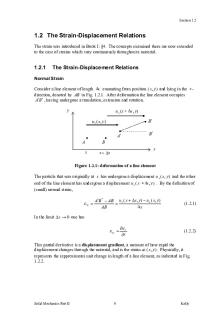Positive Displacement Meters PDF

| Title | Positive Displacement Meters |
|---|---|
| Author | MAHADEVAN S |
| Course | Diploma in Instrumentation Engineering |
| Institution | Government Polytechnic College, Neyyattinkara |
| Pages | 7 |
| File Size | 174.3 KB |
| File Type | |
| Total Downloads | 51 |
| Total Views | 148 |
Summary
To explain the working principle & Construction of Nutating disc type flow meters.
To describe the working principle & Construction of Reciprocating piston type flow meters
To illustrate the working principle & Construction of oval gear type flow meters...
Description
Positive Displacement Flowmeters Positive displacement meters are essentially flow quantity meters.They are most widely used for applications where the highest degree of accuracy and good repeatability are required .These devices work on the principle that as the liquid flows through the meter,it separates the flow of liquid into separate known volumetric increments which are counted and totalled .The sum of the increments give the measurement of the total volume of liquid passes through the meter. The positive displacement meters may be divided into the following categories (1)Nutating disc type (2)Reciprocating piston type (3) Oval gear Type Nutating Disc Meters Nutating disc meter is used extensively for residential water service measurement ,but can be used in many industrial applications.It consists of a radially allotted disc mounted on a ball bearing,as shown in the figure.An axial pin is attached with the ball which moves in a circular motion and drives a cam that is connected to a gear train and a totalizing register.The
disc is fitted into metering chamber which divides it into four volumes,two above the disc on the inlet side and two below the disc on the outlet side. As the liquid flows through the meter,pressure drops from inlet to outlet causes a wobbling or nutating motion to the disc and for each nutation of the disc a specific volume of liquid equal to the metering chamber minus the volume of the disc assembly ,passes through the meter.The movements of the disc is transmitted by the gear train to the totalizing register.
This type of flowmeter has an accuracy of ±1 to ± 2% .It is built for small pipe sizes ,and its maximum capacity is about 1500gpm. Advantages (1) Its cost is relatively low. (2) It is applicable to automatic liquid batching system. (3) It can make use of moderate pressure loss. (4) It is available in several materials of construction
Disadvantages (1) It is limited as to pipe size and capacity (2) It has a fair accuracy (3) Clean fluids only should be measured. Reciprocating Piston meters The reciprocating piston meter is the oldest of the positive displacement meter.It is widely used in petroleum industry.It is similar in construction to a reciprocating steam engine piston and cyinder.It consists of a cast iron cylinder fitted with a piston .Two slide valves are attached at the inlet and outlet ports.The fluid to be measured enters through the inlet forcing the piston to the left until the cylinder is full and piston is in extreme left position .At this point an external leakage causes the side walls to move and thus the liquid enters the left cylinder forcing the piston to its extreme right position.When the cylinder becomes full the slide valves again moved and the cycle is repeated.The external arms of the slide valves drives a counter which provides a total of the fluid quantity that has passed
through the meter.Instead of one piston a number of piston operating on a center crank and generally incorporated with this meter.
Figure: Reciprocating meters are available in many forms such as multipiston meters,double acting piston meters,rotary valves, and horizontal slide valves.The accuracy of these meters are from ±0.2 to ±0.3% Advantages 1.Its accuracy is high 2.Construction materials are not limited in reciprocating piston meters Limitations 1.Their cost is relatively high 2.They are subject to leakage 3.Problems are created by dirty fluids
4.It requires high maintainence cost. 5.It is restricted to moderate flowrats 6.It produces pulsating flow when using for liquid measurement
Oval Gear Flow Meter
Oval gear flow meters are a type of positive displacement meter. As liquid flows through the meter, a pair of oval shaped gears are forced to rotate by the flow of the liquid. These gears mesh together & force a finite amount of fluid through the meter. A sensor or mechanical drive detects the rotation of the gears to determine the displaced volume of liquid. The faster the flow rate, the faster the gears turn. Principle of operation Oval gear flowmeter features two precisely machined rotating elliptical (oval) gears which rotate and mesh within the meter's interior housing in order to form a measuring chamber of known volume A fixed quantity of liquid passes through the meter for each revolution. Shaft rotation can be monitored to obtain specific flow rates . The Oval Gear flow meter accurately measures liquid flow by using a
slight pressure differential to rotate a pair of oval gears located within the measuring chamber. These meshed gears seal the inlet from the outlet flow, developing a pressure differential. Each complete rotation of the gears, or rotors, displaces a fixed amount of liquid from the inlet to the outlet of the meter in a continuous flow pattern.A sensor or mechanical drive detects the rotation of the gears to determine the displaced volume of liquid. The faster the flow rate, the faster the rotation. Advantages Traditional proven flow technology Simple to install No straight pipe runs required so flow meters can be installed in restricted areas Limitations
Not suitable for steam or multi-phase fluids Fluid slippage adversely affects accuracy; this varies with flow rate, differential pressure, temperature, viscosity and clearance Not recommended for low-viscosity fluids, including water or water-like fluids (because of an increase in fluid slippage)
Accuracy adversely affected by bubbles present in fluids The oval gear flow meter is designed primarily for use with higher-viscosity fluids, which has led to applications such as the flow metering of oils, syrups and fuels . ...
Similar Free PDFs

Positive Displacement Meters
- 7 Pages

Double Displacement Reactions
- 2 Pages

Displacement and Density Workbook
- 13 Pages

positive relationships
- 4 Pages

Libertà positive
- 15 Pages

Positive Parenting Plan
- 5 Pages

Positive Personal Qualities
- 1 Pages

Slavery- A Positive Good
- 3 Pages

Positive consumption externality
- 1 Pages
Popular Institutions
- Tinajero National High School - Annex
- Politeknik Caltex Riau
- Yokohama City University
- SGT University
- University of Al-Qadisiyah
- Divine Word College of Vigan
- Techniek College Rotterdam
- Universidade de Santiago
- Universiti Teknologi MARA Cawangan Johor Kampus Pasir Gudang
- Poltekkes Kemenkes Yogyakarta
- Baguio City National High School
- Colegio san marcos
- preparatoria uno
- Centro de Bachillerato Tecnológico Industrial y de Servicios No. 107
- Dalian Maritime University
- Quang Trung Secondary School
- Colegio Tecnológico en Informática
- Corporación Regional de Educación Superior
- Grupo CEDVA
- Dar Al Uloom University
- Centro de Estudios Preuniversitarios de la Universidad Nacional de Ingeniería
- 上智大学
- Aakash International School, Nuna Majara
- San Felipe Neri Catholic School
- Kang Chiao International School - New Taipei City
- Misamis Occidental National High School
- Institución Educativa Escuela Normal Juan Ladrilleros
- Kolehiyo ng Pantukan
- Batanes State College
- Instituto Continental
- Sekolah Menengah Kejuruan Kesehatan Kaltara (Tarakan)
- Colegio de La Inmaculada Concepcion - Cebu






